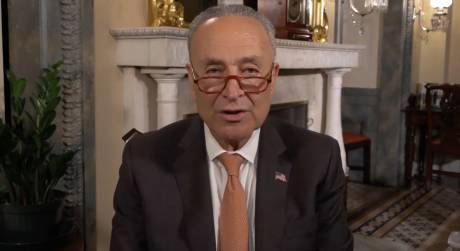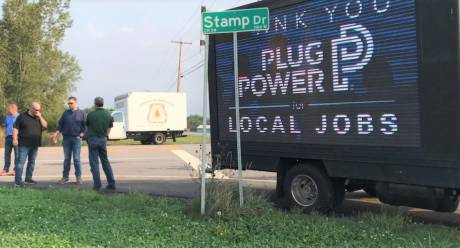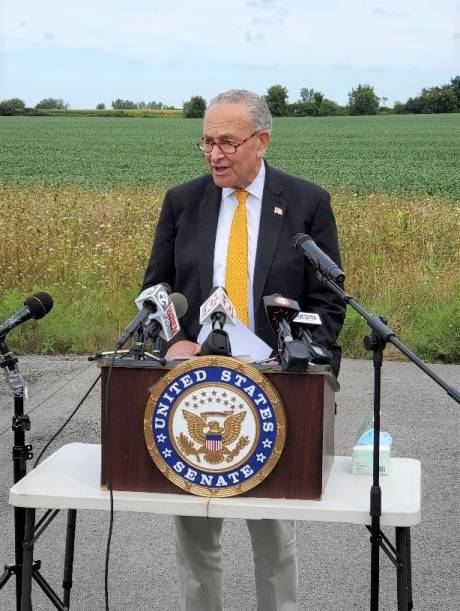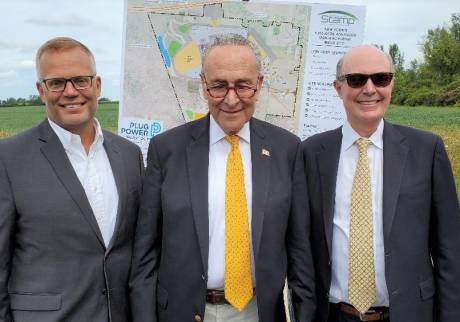Today, U.S. Senate Majority Leader Charles E. Schumer filed the bipartisan U.S. Innovation and Competition Act, which combines Schumer’s Endless Frontier Act, other bipartisan competitiveness bills, and $52 billion in emergency supplemental appropriations to implement the semiconductor-related manufacturing and R&D programs authorized in last year’s National Defense Authorization Act and a program to support legacy chip production that is essential to the auto industry, the military, and other critical industries.
An additional $1.5 billion is provided for implementation of implement the USA Telecommunications Act that was also passed as part of last year’s NDAA to foster U.S. innovation in the race for 5G. This package of innovation bills will receive a final Senate vote in the days ahead.
“The U.S. Innovation And Competition Act will be the blueprint to make Upstate New York the global innovation and semiconductor hub as one of the most significant government investments in American innovation and manufacturing in generations,” said Senate Majority Leader Schumer.
“I’m proud that this bipartisan legislation advances my Endless Frontier Act to keep the U.S. on the cutting-edge of technology and provides a historic investment in the nation’s semiconductor industry that will strengthen national security and create jobs across Upstate New York. We must invest in R&D, innovation, and manufacturing to ensure the U.S. continues to lead the world in science and technology. The Empire state is the perfect place to grow innovation industries, including our semiconductor R&D and manufacturing, and my amendment will solidify New York as a global hub for technology.”
Schumer added, “I’m making it a top priority to move quickly and secure the necessary funding to stand up the semiconductor programs I fought to pass into law last year that will bring us one step closer to ensuring our domestic semiconductor industry can safely and securely supply our military, intelligence agencies, and other government needs. This is a step essential to growth in high-tech R&D, manufacturing, and jobs across Upstate New York and to our national security and U.S. leadership in this critical industry."
Details on the supplemental appropriations proposed by Senator Schumer appear below:
· $49.5 billion allocated over 5 years for a CHIPS for America Fund. Funding must be used to implement the Commerce Department semiconductor incentive and R&D programs authorized by the FY21 NDAA (Sec. 9902 & 9906). Within the fund, the following appropriations are available:
o Incentive Program: $39 billion appropriated upfront and allocated over 5 years to implement the programs authorized in Sec. 9902. $2 billion is provided to solely focus on legacy chip production to advance the economic and national security interests of the United States.
§ $19 billion in FY22, including the $2 billion legacy chip production funding
§ $5 billion each year, FY23 through FY26
o Commerce R&D programs: $10.5 billion appropriated upfront and allocated over 5 years to implement programs authorized in Sec. 9906, including the National Semiconductor Technology Center (NSTC), National Advanced Packaging Manufacturing Program, and other R&D programs authorized in Sec. 9906.
§ $5 billion in FY22
· $2.5 billion for advanced packaging
· $2 billion for NSTC
· $500 million for other related R&D programs
For use across the advanced packaging, NSTC, and other related R&D programs, the following would be provided:
§ $2 billion in FY23
§ $1.3 billion in FY24
§ $1.1 for FY25 and FY26
· $2 billion for a CHIPS for America Defense Fund: Funding is appropriated up front and $400 million is allocated each year, over 5 years for the purposes of implementing programs authorized in Sec. 9903(b), providing support for R&D, testing and evaluation, workforce development, and other related activities, in coordination with the private sector, universities, and other Federal agencies to support the needs of the Department of Defense and the intelligence community.
· $500 million for a CHIPS for America International Technology Security and Innovation Fund: Funding is appropriated upfront and $100 million each year, allocated over 5 years to the Department of State, in coordination with the U.S. Agency for International Development, the Export-Import Bank, and the U.S. International Development Finance Corporation, for the purposes of coordinating with foreign government partners to support international information and communications technology security and semiconductor supply chain activities, including supporting the development and adoption of secure and trusted telecommunications technologies, semiconductors, and other emerging technologies.
An additional $1.5 billion is provided for the implementation of implementing the USA Telecommunications Act that was also passed as part of last year’s NDAA to foster U.S. innovation in the race for 5G.
Details on the Endless Frontier Act:
The Endless Frontier Act, as reported by the Senate Commerce Committee, seeks to maintain and build on U.S. science and technology leadership through investments in research and 5 development and strengthening regional economic development, manufacturing, and supply chains. The legislation would authorize roughly $120 billion over 5 years for activities at the National Science Foundation (“NSF”), Department of Commerce (“DOC”), the Department of Energy (“DOE”), and the National Aeronautics and Space Administration (“NASA”).
The Endless Frontier Act advances priorities including reducing undue geographic concentration of R&D funding, encourage broader participation of populations underrepresented in STEM, and increase collaboration across federal agencies and with non-governmental partners on innovation.
Notable Provisions:
· Technology Directorate: The Endless Frontier Act would create a new Directorate of Technology and Innovation at the NSF to support research and technology development in key technology focus areas, such as artificial intelligence and quantum science, in order to strengthen the global leadership of the United States in innovation. Major activities would include funding research and development at collaborative institutes, supporting academic technology transfer and intellectual property protection, establishing technology testbeds, and awarding scholarships and fellowships to build the relevant workforce. The Directorate would be authorized at $29 billion over fiscal years 2022 to 2026, including a transfer of $2.9B to existing NSF divisions to support basic research collaboration.
· NSF Research and Development Programs: The Endless Frontier Act would authorize $52 billion over fiscal years 2022 to 2026 for existing NSF activities, representing a seven percent increase each year. The legislation would also create a Chief Diversity Officer at NSF and increase STEM education to enhance the domestic STEM workforce. The legislation also incorporates a series of new programs, including programs for precision agriculture, rural STEM education, quantum information science, skilled technical education, critical minerals, and bioeconomy R&D.
· Regional Technology Hubs: The Endless Frontier Act creates a regional technology hub program at DOC to support regional economic development in innovation. Technology hubs would carry out workforce development activities, business and entrepreneur development activities, technology maturation activities, and infrastructure activities related to the technology development. The technology hubs program would be authorized at $10 billion over fiscal years 2022 to 2026.
· Manufacturing: The Endless Frontier Act would authorize close to a quadrupling of the DOC Manufacturing Extension Partnership and create a new track within the program for public benefit activities like workforce development and cybersecurity services. The Manufacturing Extension Partnership would be funded at $2.4B over fiscal years 2022 to 2026. The substitute would also authorize the Manufacturing USA program, at $1.2B over fiscal years 2022 to 2026, and add workforce and coordination provisions.
· Supply Chain Resiliency: The Endless Frontier Act would establish a supply chain resiliency program at the Department of Commerce to work with the private sector, for the purpose of identifying and recommending opportunities to mitigate or address supply chain vulnerabilities in the United States and in allied and partner countries. It would also amend the recently-enacted CHIPS Act to provide $2 billion in incentives for domestic production of mature semiconductor technologies, such as for the automotive industry.
Schumer’s U.S. Innovation and Competition Act is supported throughout the state. Supporters include:
"GLOBALFOUNDRIES thanks Senate Majority Leader Chuck Schumer for his leadership, his ongoing support of our industry, and his forward-looking perspective on U.S. chip manufacturing,” said GlobalFoundries CEO Tom Caulfield. “The semiconductor supply chain is not only a top priority for the U.S., but also a global issue with many countries looking to bolster their own chip production. The Endless Frontiers Act has bipartisan sponsorship and great momentum - the time is now to act to pass the bill and ensure that the U.S. is not left behind in the race to secure onshore chip manufacturing."
M&T Bank Chairman and CEO Rene F. Jones said, “As a bank for communities, we understand that economic development and prosperity requires building an “ecosystem” that attracts, retains, develops, and engages modern talent, creating sustainable and equitable engines for economic growth. This is especially true in small and mid-tier cities, where we serve and across the country. In cities like Buffalo and Rochester, we are building a new technology hub and hosting a growing number of innovative entrepreneurial businesses that support long-term competitiveness. The Endless Frontier Act sponsored by Senators Schumer and Young has bipartisan support and backing from the business community because it helps the United States regain our position as the world’s leader in technology and innovation while building out economic opportunities that are inclusively distributed across the country.”
Greater Rochester Chamber of Commerce President and CEO Bob Duffy said, “Upstate New York, and especially the Greater Rochester/Finger Lakes region, is poised to become a global hub for the critical semiconductor manufacturing industry. Greater Rochester Chamber of Commerce wholeheartedly supports Senator Schumer’s amendment to the Endless Frontiers Act, which will invest in much-needed infrastructure like our Genesee County STAMP facility. This will not only help create jobs and bolster the economy in our region, but drive innovation, advancement, and competitiveness for our nation. We are grateful to Senator Schumer for his continued leadership and for championing the EFA.”
"Senate Majority Leader Schumer has long-championed upstate New York as the ideal region for critical growth of the domestic semiconductor manufacturing and R&D investments due to our university research and talent, our established and ever-growing semiconductor supply chain, along with our considerable capacity of renewable, reliable, and competitively priced electricity,” said Steve Hyde, president & CEO, Genesee County Economic Development Center. “We applaud Senator Schumer for his leadership, and agree that passage of the Endless Frontiers Act and the recommended appropriations would be catalytic in growing the high-tech economy at the Western New York Science & Technology Advanced Manufacturing Park (STAMP) and all across upstate New York."
Hudson Valley Economic Development Corporation President and CEO Mike Oates said, “HVEDC applauds Senator Schumer’s leadership in championing the Endless Frontier Act, which will invest in the Hudson Valley's growing semiconductor manufacturing industry and high-tech research and development initiatives. The Endless Frontier Act will bolster technological innovation and create jobs as we welcome global industry leaders like ON Semi to town. We thank Senator Schumer for his continued efforts to grow the Hudson Valley’s global footprint as a leader in semiconductor manufacturing and innovation.”
“EWI applauds Senator Schumer’s leadership in advancing the bipartisan Endless Frontier Act,” said Henry Cialone, president and CEO of Buffalo Manufacturing Works/EWI. To compete on a global scale, manufacturers must be able to make effective use of emerging technologies such as additive manufacturing, advanced metal stamping with servo technology, and next generation nondestructive inspection – innovations that drive productivity, quality, and reduce cost. EWI enthusiastically supports this bill because it focuses on increasing U.S. manufacturing competitiveness through innovation and investing in the manufacturing workforce.”
Buffalo Niagara Partnership President and CEO Dottie Gallagher said, “The Endless Frontier Act represents a once-in-a-lifetime opportunity to turbo charge scientific and technological innovation in the United States. Buffalo Niagara’s economy will benefit tremendously in repositioning America as the world’s true technology leader with a critical focus on manufacturing, research, and workforce development. The Buffalo Niagara Partnership supports this bipartisan legislation and strongly advocates for its passage. The BNP commends Senator Schumer for leading this effort.”
"From our automobiles to our smart phones to the appliances in our kitchens, semiconductors are critical, not just to our national security, but to our everyday life,” said Oneida County Executive Anthony J. Picente Jr. “Senator Schumer’s leadership in ensuring that we continue to build domestic research and production capacity, encouraging more companies like CREE-Wolfspeed to invest, is great news for America and Oneida County.”
Onondaga County Executive Ryan McMahon said, “Passing this bill will be a significantly important step towards securing a semiconductor manufacturing facility in Onondaga County. Our site is known across the globe for its easy access to affordable water and power along with our great quality of life. Thank you to Senator Schumer for his steadfast leadership and advocacy for this bill and our community.”
“ON Semiconductor applauds the inclusion of CHIPS for America Act funding in the Endless Frontiers Act substitute amendment,” said Hassane El-Khoury, president and CEO of ON Semiconductor. “The Act will help America compete with its trading partners who have been aggressively supporting semiconductor research and manufacturing in their countries."
A section-by-section summary of the United States Innovation and Competition Act of 2021 can be found here and the text of the legislation can be found here.









